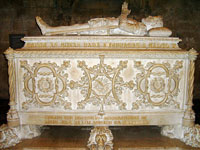- «Portuguese Homer» Luís de Camões
- Poem «The Lusiads»
- Mikhail Travchetov – the Translator of «The Lusiads»
- Manuscript of M. Travchetov's Translation
- Reference Literarure
«Portuguese Homer» Luís de Camões

Unable to obtain acceptance in the homeland, he went to India in 1553. Camões didn't get on with the Governor of Goa, and soon, he found himself in Macau, the first Portuguese colony in China. For six years in Macao, he made a considerable fortune and, most importantly, wrote the work of his life – «The Lusiads».
During his return journey, he was shipwrecked. The poet lost everything, saving only the manuscript of the poem in his hands. In 1572, Poem «The Lusiads» was published twice and enjoyed extraordinary success. Despite this, Camões spent his last years in extreme poverty. He was died on 10 June, 1580, and was buried in the convent of Santa Ana. The poet's gravestone bears the inscription, 'Here lies Luis Camoes, Prince of the Poets of his time. He lived poor and neglected, and so died. Summer MDLXXIX'. In 1755, an earthquake destroyed the grave of the poet, the tomb was later recreated in the Jeronimos Monastery founded in 1450 by Henry the Navigator, in Lisbon. In the monastery, Camões is buried near another great Portuguese figure and the hero of his poem Vasco da Gama.
